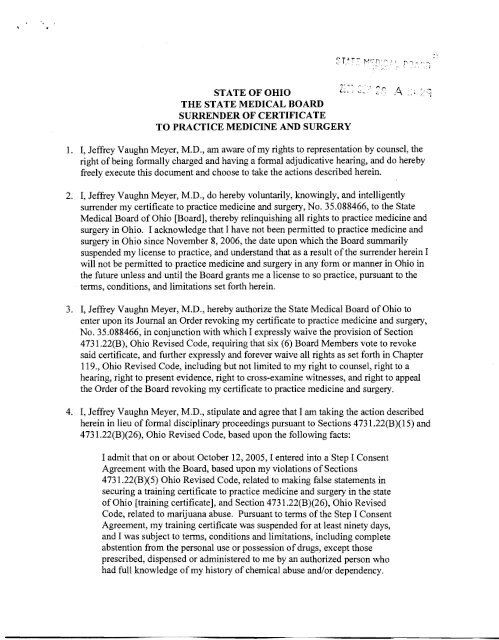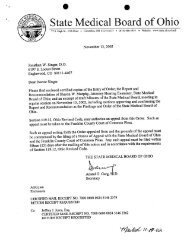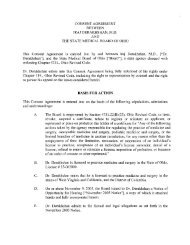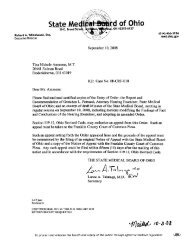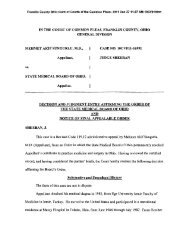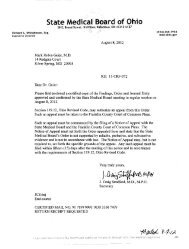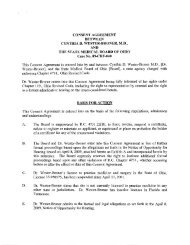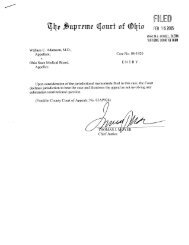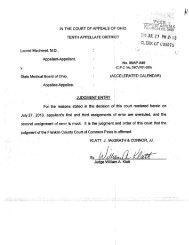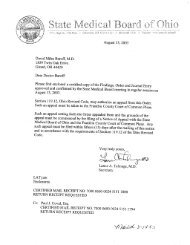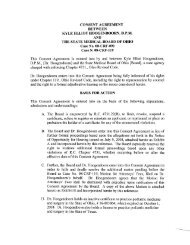Untitled - State Medical Board of Ohio - State of Ohio
Untitled - State Medical Board of Ohio - State of Ohio
Untitled - State Medical Board of Ohio - State of Ohio
Create successful ePaper yourself
Turn your PDF publications into a flip-book with our unique Google optimized e-Paper software.
Report and Recommendation<br />
In the Matter <strong>of</strong> Jeffrey Vaughn Meyer, M.D.<br />
Page 2<br />
I. Testimony Heard<br />
Jeffrey Vaughn Meyer, M.D.<br />
Kathleen Petersen, Esq.<br />
Danielle Bickers<br />
William J. Closson, Ph.D.<br />
R. Jason Jones, L.I.C.D.C.<br />
Alfred E. Staubus, Pharm.D., Ph.D.<br />
II. Exhibits Examined<br />
A. Presented by the <strong>State</strong><br />
EVIDENCE EXAMINED<br />
<strong>State</strong>’s Exhibits 1A through 1R: Procedural exhibits.<br />
<strong>State</strong>’s Exhibit 2: Documents maintained by the <strong>Board</strong> in the Matter <strong>of</strong> Jeffrey<br />
Vaughn Meyer, M.D.<br />
<strong>State</strong>’s Exhibit 3: Toxicology results for the urine specimen <strong>of</strong> October 10, 2006.<br />
<strong>State</strong>’s Exhibit 4: Toxicology results for the urine specimens <strong>of</strong> September 28,<br />
October 19, and October 25, 2006.<br />
<strong>State</strong>’s Exhibit 5: Curriculum vitae <strong>of</strong> William J. Closson, Ph.D.<br />
<strong>State</strong>’s Exhibit 6: Laboratory documents related to the urine specimen <strong>of</strong> October 10,<br />
2006, redacted in part.<br />
B. Presented by the Respondent<br />
Respondent’s Exhibit A: Curriculum vitae <strong>of</strong> R. Jason Jones, L.I.C.D.C.<br />
Respondent’s Exhibit B: December 15, 2006, letter from Doug Blair, M.A.,<br />
L.I.C.D.C.<br />
Respondent’s Exhibit C: Picture <strong>of</strong> a bottle <strong>of</strong> “Dr. Bronner’s 18-n-1 Hemp Almond<br />
Pure-Castille Soap.”<br />
Respondent’s Exhibit D: Curriculum vitae <strong>of</strong> Alfred E. Staubus, Pharm.D., Ph.D.<br />
Respondent’s Exhibit E: Excerpts from Disposition <strong>of</strong> Toxic Drugs and Chemicals in<br />
Man, Sixth Edition, by Randall C. Baselt.
Report and Recommendation<br />
In the Matter <strong>of</strong> Jeffrey Vaughn Meyer, M.D.<br />
Page 3<br />
Respondent’s Exhibit F: December 7, 2006, toxicology results for hemp soap from<br />
The <strong>Ohio</strong> <strong>State</strong> University Reference Laboratories.<br />
Respondent’s Exhibit G: December 13, 2006, report from Dr. Staubus.<br />
Respondent’s Exhibit H: Bottle <strong>of</strong> “Dr. Bronner’s 18-n-1 Hemp Almond Pure-<br />
Castille Soap.”<br />
Respondent’s Exhibit I: 2005 advocacy agreement between Jeffrey V. Meyer, M.D.,<br />
and <strong>Ohio</strong> Physicians Health Program Inc.<br />
PROCEDURAL MATTERS<br />
At the conclusion <strong>of</strong> the hearing, the Hearing Examiner requested and the Respondent agreed to<br />
provide an additional document, the 2005 advocacy agreement between Dr. Meyer and <strong>Ohio</strong><br />
Physicians Health Program Inc. The Hearing Examiner held the record open for that purpose.<br />
On December 20, 2006, Respondent provided that document. It was marked and admitted as<br />
Respondent’s Exhibit I. The hearing record closed on December 20, 2006.<br />
Upon review <strong>of</strong> the record, the Hearing Examiner noted that one procedural document,<br />
Respondent’s Second Supplemental List <strong>of</strong> Witnesses and Exhibits, was not included in the<br />
procedural exhibits. The Hearing Examiner reopened the record on January 8, 2007, marked that<br />
document, and admitted it into the record as <strong>State</strong>’s Exhibit 1R. The hearing record thereafter<br />
closed on January 8, 2006.<br />
SUMMARY OF THE EVIDENCE<br />
All exhibits and the transcript, even if not specifically mentioned, were thoroughly reviewed and<br />
considered by the Hearing Examiner prior to preparing this Report and Recommendation.<br />
Throughout this report and recommendation, the words “marijuana,” “THC,” and<br />
“cannabinoids” are used interchangeably for the family <strong>of</strong> substances that comprise marijuana.<br />
Dr. Meyer’s Background and <strong>Ohio</strong> Training Certificate<br />
1. Jeffrey Vaughn Meyer, M.D., graduated from the University <strong>of</strong> Kansas with a bachelor’s<br />
degree in mathematics. He obtained a medical degree from Wake Forest University in<br />
1999. He completed a five-year residency in pathology at Wake Forest University as well.<br />
(Hearing Transcript [Tr.] at 185)<br />
2. In the summer <strong>of</strong> 2005, the <strong>Board</strong> issued a training certificate to Dr. Meyer. He planned to<br />
begin a surgical pathology fellowship at The <strong>Ohio</strong> <strong>State</strong> University. In order to begin the<br />
fellowship, Dr. Meyer provided a urine sample on or about July 7, 2005. That specimen
Report and Recommendation<br />
In the Matter <strong>of</strong> Jeffrey Vaughn Meyer, M.D.<br />
Page 4<br />
tested positive for marijuana. (<strong>State</strong>’s Exhibit [St. Ex.] 2 at 21) As a result, Dr. Meyer was<br />
precluded from the fellowship. (Tr. at 185-186, 201)<br />
3. On or about August 15, 2005, Dr. Meyer entered Shepherd Hill, a <strong>Board</strong>-approved<br />
treatment provider in Newark, <strong>Ohio</strong>, to undergo a three-day inpatient evaluation to<br />
determine if he was impaired. The urine sample that Dr. Meyer provided upon entering<br />
Shepherd Hill tested positive for marijuana. Dr. Meyer testified that he did not use<br />
marijuana between July 7 and August 15, 2005, and yet he was “still testing positive” for<br />
marijuana. (Tr. at 187-188) Shepherd Hill diagnosed Dr. Meyer with cannabis abuse and<br />
concluded that he was impaired in his ability to practice according to acceptable and<br />
prevailing standards <strong>of</strong> care. (St. Ex. 2 at 21; Tr. at 187, 201)<br />
4. In light <strong>of</strong> that diagnosis and in lieu <strong>of</strong> formal proceedings, Dr. Meyer entered into a Step I<br />
Consent Agreement on October 12, 2005, with the <strong>Board</strong> [Step I agreement]. The Step I<br />
agreement reflects that the <strong>Board</strong> entered into the Step I agreement based upon Dr. Meyer’s<br />
violations <strong>of</strong> Sections 4731.22(B)(5) and (B)(26), <strong>Ohio</strong> Revised Code. In the Step I<br />
agreement, Dr. Meyer admitted that he had used marijuana every other weekend between<br />
January and May 2005. Pursuant to the Step I agreement, Dr. Meyer’s training certificate<br />
was indefinitely suspended for at least 90 days, and Dr. Meyer was required, among other<br />
things, to maintain sobriety, submit to random urine screens, and participate in a<br />
rehabilitation program. The agreement also included a list <strong>of</strong> terms, conditions, and<br />
limitations that had to be fulfilled in order for the <strong>Board</strong> to consider reinstatement or<br />
renewal <strong>of</strong> Dr. Meyer’s training certificate, or issuance <strong>of</strong> any other certificate to<br />
Dr. Meyer. (St. Ex. 2 at 20-27)<br />
5. On or about October 11, 2005, Dr. Meyer entered the Woods at Parkside [Parkside], a<br />
<strong>Board</strong>-approved treatment provider in Columbus, <strong>Ohio</strong>, to undergo inpatient treatment.<br />
Dr. Meyer testified that he had last used marijuana on October 1, 2005, and a drug test<br />
taken while at Parkside later that month was positive for marijuana. (Tr. at 187, 202)<br />
Dr. Meyer successfully completed that 28-day treatment and was discharged in November<br />
2005. He thereafter participated in an aftercare contract with Parkside and in an advocacy<br />
contract with the <strong>Ohio</strong> Physicians Health Program Inc. [OPHP] Later, two physicians<br />
reported that Dr. Meyer was capable <strong>of</strong> practicing medicine and surgery according to<br />
acceptable and prevailing standards <strong>of</strong> care, so long as certain treatment and monitoring<br />
requirements are in place. (St. Ex. 2 at 11-12; Tr. at 188-189)<br />
6. Dr. Meyer’s <strong>Ohio</strong> training certificate was suspended on October 12, 2005. He did not seek<br />
to reinstate or renew that training certificate, and it expired on June 30, 2006. (St. Ex. 2 at<br />
10-11)
Report and Recommendation<br />
In the Matter <strong>of</strong> Jeffrey Vaughn Meyer, M.D.<br />
Page 5<br />
Dr. Meyer’s Current <strong>Ohio</strong> Certificate and Employment<br />
7. In April 2006, Dr. Meyer submitted an application for a certificate to practice medicine and<br />
surgery in <strong>Ohio</strong>. Dr. Meyer began a one-year forensic pathology fellowship with the<br />
Franklin County Coroner’s Office in July 2006. (St. Ex. 2 at 11; Tr. at 185)<br />
8. Dr. Meyer entered into a Step II Consent Agreement with the <strong>Board</strong> [Step II agreement],<br />
effective August 9, 2006. The <strong>Board</strong> granted Dr. Meyer a certificate, subject to various<br />
probationary terms, conditions and limitations for a five-year period. Those Step II terms,<br />
conditions and limitations include the following:<br />
Paragraph 8: Dr. Meyer shall abstain completely from the personal use or<br />
possession <strong>of</strong> drugs, except those prescribed, dispensed or administered to him<br />
by another so authorized by law who has full knowledge <strong>of</strong> Dr. Meyer’s history<br />
<strong>of</strong> chemical dependency.<br />
Paragraph 9: Dr. Meyer shall abstain completely from the use <strong>of</strong> alcohol.<br />
Paragraph 10: Dr. Meyer shall submit to random urine screenings for drugs<br />
and alcohol on a weekly basis or as otherwise directed by the <strong>Board</strong>.<br />
Dr. Meyer shall ensure that all screening reports are forwarded directly to the<br />
<strong>Board</strong> on a quarterly basis. The drug testing panel utilized must be acceptable<br />
to the Secretary <strong>of</strong> the <strong>Board</strong>.<br />
Dr. Meyer shall abstain from consumption <strong>of</strong> poppy seeds or any other food or<br />
liquid that may produce false results in a toxicology screen.<br />
Dr. Meyer and the <strong>Board</strong> agree that the person or entity previously approved by<br />
the <strong>Board</strong> to serve as Dr. Meyer’s supervising physician pursuant to the<br />
October 2005 Step I Consent Agreement is hereby approved to continue as<br />
Dr. Meyer’s designated supervising physician under this [Step II] Agreement<br />
* * *. Dr. Meyer and the supervising physician shall ensure that the urine<br />
specimens are obtained on a random basis and that the giving <strong>of</strong> the specimen<br />
is witnessed by a reliable person. In addition, the supervising physician shall<br />
assure that appropriate control over the specimen is maintained and shall<br />
immediately inform the <strong>Board</strong> <strong>of</strong> any positive screening results. Further, the<br />
supervising physician shall ensure that additional testing <strong>of</strong> urine specimens for<br />
ethyl glucuronide is done on a random basis to include at least one out <strong>of</strong> every<br />
four urine specimens.<br />
* * *<br />
Paragraph 16: Dr. Meyer shall maintain continued compliance with the terms<br />
<strong>of</strong> the advocacy agreement entered into with the <strong>Ohio</strong> Physicians Health<br />
Program, or, if approved in advance by the <strong>Board</strong>, another physicians health
Report and Recommendation<br />
In the Matter <strong>of</strong> Jeffrey Vaughn Meyer, M.D.<br />
Page 6<br />
program, provided that, where terms <strong>of</strong> the advocacy agreement conflict with<br />
terms <strong>of</strong> this [Step II] Agreement, the terms <strong>of</strong> this [Step II] Agreement shall<br />
control.<br />
(St. Ex. 2 at 13-14, 16)<br />
Further, Dr. Meyer agreed in the Step II agreement that, if the secretary and supervising<br />
member <strong>of</strong> the <strong>Board</strong> determine that there is clear and convincing evidence that Dr. Meyer<br />
has violated any term, condition or limitation <strong>of</strong> the Step II agreement, the alleged<br />
violation also constitutes clear and convincing evidence that his continued practice<br />
presents a danger <strong>of</strong> immediate and serious harm to the public for purposes <strong>of</strong> initiating a<br />
summary suspension pursuant to Section 4731.22(G), <strong>Ohio</strong> Revised Code. (St. Ex. 2, at<br />
18)<br />
9. The advocacy agreement with OPHP had been previously executed in late 2005. The first<br />
provision <strong>of</strong> the advocacy agreement requires Dr. Meyer to abstain from all mood-altering<br />
drugs including alcohol, prescription drugs, over-the-counter preparations, and foods<br />
having substances that could yield a positive toxicology test results (e.g. poppy seeds,<br />
rumcakes, cough syrups, cold medications, and mouthwash). (Respondent’s [Resp.]. Ex. I;<br />
Tr. at 172)<br />
Dr. Meyer’s Toxicology Results<br />
10. Dr. Meyer provided random, weekly urine specimens in September 2006 and October 2006<br />
as directed. However, he was granted waivers or exemptions <strong>of</strong> certain Step II<br />
requirements during the week <strong>of</strong> October 2, 2006, while he attended an out-<strong>of</strong>-state, workrelated<br />
conference. Specifically, Dr. Meyer was allowed to miss the urine testing and<br />
allowed to miss some <strong>of</strong> the required support group meetings during the week <strong>of</strong> October 2,<br />
2006. (Tr. at 27, 45-46, 190-191, 193)<br />
11. The toxicology results for Dr. Meyer’s urine specimens were negative until October 2006.<br />
The urine specimen that Dr. Meyer provided on or about October 10, 2006, initially tested<br />
positive for marijuana and was confirmed for the presence <strong>of</strong> cannabinoids. (St. Ex. 3)<br />
12. Upon receiving the toxicology results from the October 10, 2006, urine specimen, the<br />
<strong>Board</strong> took the matter under a consideration. Then, the <strong>Board</strong> decided to summarily<br />
suspend Dr. Meyer’s certificate, and ordered Dr. Meyer to immediately cease practicing<br />
medicine in <strong>Ohio</strong>. (St. Ex. 1A)<br />
13. Dr. Meyer’s September 2006 and October 2006 urine specimens were tested by Bendiner<br />
& Schlesinger Inc. [B&S] for the presence <strong>of</strong> 10 different drugs and for the dilution level.<br />
(St. Exs. 3, 4; Tr. at 140-142)
Report and Recommendation<br />
In the Matter <strong>of</strong> Jeffrey Vaughn Meyer, M.D.<br />
Page 7<br />
14. William J. Closson, Ph.D., is the director <strong>of</strong> the toxicology department at B&S. 1<br />
Dr. Closson explained how specimens arrive at B&S, are handled, identified, evaluated for<br />
acceptability, stored, tested, and certified. (Tr. at 67-76, 78-79)<br />
Dr. Closson testified that, for urine specimens, B&S utilizes an initial screening test called<br />
“EMIT,” which stands for enzyme multiplied immunoassay technique, to detect the<br />
presence <strong>of</strong> 10 different drugs in urine. According to Dr. Closson, EMIT is used by 95<br />
percent <strong>of</strong> the forensic toxicology laboratories and has a 95 percent accuracy rating. If a<br />
positive result is detected under the EMIT test and/or if other factors warrant, a second<br />
higher-level test called “GC/MS,” which stands for gas chromatography/mass<br />
spectrometry, is conducted to confirm the drug’s presence in the urine and measure its<br />
level. Dr. Closson noted that GC/MS is the “only technology that is allowed for the<br />
confirmatory testing in urine drug testing, and it’s required by the federal government and<br />
also by the New York <strong>State</strong> Department <strong>of</strong> Health as being the required confirmatory test.”<br />
Further, he stated that the GC/MS test is more than 99.9 percent reliable. (Tr. at 72, 75, 77,<br />
135)<br />
15. Further, Dr. Closson explained the features <strong>of</strong> marijuana and the ability to detect marijuana<br />
in persons who have used or consumed it. He stated that there are various metabolites <strong>of</strong><br />
marijuana. The initial EMIT test uses an antibody that reacts with most <strong>of</strong> the more than<br />
40 known metabolites <strong>of</strong> marijuana. Thus, Dr. Closson stated that the initial test is<br />
designed to recognize a broad spectrum <strong>of</strong> marijuana metabolites. The GC/MS test is used<br />
because it will create a mass spectrum <strong>of</strong> marijuana. Dr. Closson testified that the GC/MS<br />
test looks for the primary metabolite <strong>of</strong> marijuana because it is present in virtually every<br />
person’s urine if he/she has used or consumed marijuana. With the GC/MS test, B&S can<br />
detect levels <strong>of</strong> marijuana from 2 nanograms to 400 nanograms per milliliter. (Tr. at 74,<br />
76-77, 139)<br />
Also, Dr. Closson explained that the standard consensus among toxicologists is that one<br />
who uses marijuana once or twice a week would have the marijuana in his/her system for<br />
three to five days afterward. In contrast, a user who has used marijuana daily for several<br />
months would usually have marijuana in his/her system for as long as three to five weeks<br />
after cessation. (Tr. at 81-82, 125-126)<br />
16. Relative to the testing <strong>of</strong> Dr. Meyer’s October 10 urine specimen, Dr. Closson explained<br />
the various tests, the results, the point at which a positive result is determined to exist, and<br />
the safeguards utilized by B&S. (Tr. at 90-111, 116-119; St. Ex. 6). Dr. Closson<br />
characterized the GC/MS positive test result <strong>of</strong> 46 nanograms <strong>of</strong> THC per milliliter as a<br />
moderate amount, as opposed to a trace amount. Fifteen nanograms <strong>of</strong> THC per milliliter<br />
is the point at which a GC/MS positive result is declared or the “cut<strong>of</strong>f level.” Dr. Closson<br />
also testified that B&S measures the specimen’s creatinine level to indicate how dilute the<br />
1 Dr. Closson has a bachelor’s degree in biology from <strong>State</strong> University <strong>of</strong> New York at Stony Brook, a master’s<br />
degree in biochemistry from Long Island University, and a doctorate in biochemistry and toxicology from St. John’s<br />
University. He is licensed as a forensic toxicologist by the <strong>State</strong> <strong>of</strong> New York, certified as a blood-alcohol analyst<br />
by the <strong>State</strong> <strong>of</strong> New York, and certified by the American <strong>Board</strong> <strong>of</strong> Forensic Examiners. (Tr. at 64-65; St. Ex. 5)
Report and Recommendation<br />
In the Matter <strong>of</strong> Jeffrey Vaughn Meyer, M.D.<br />
Page 8<br />
specimen is because the dilution level directly impacts the quantitative amount <strong>of</strong> the drug<br />
in a specimen. A creatinine level <strong>of</strong> 155 milligrams per deciliter is within the normal<br />
range, but a creatinine level <strong>of</strong> 16.7 milligrams per deciliter is abnormally low and<br />
potentially diluted. If the creatinine level is found to be abnormal, B&S will measure the<br />
“specific gravity” <strong>of</strong> the specimen as another means for evaluating dilution. (Tr. at 124-<br />
125, 141-144)<br />
Dr. Closson further explained that B&S’ accuracy rate is 80 percent; or, in other words,<br />
there is a plus or minus 20 percent quantitative variability. (Tr. at 114-115)<br />
17. Upon cross-examination, Dr. Closson noted that B&S uses a single-point calibration<br />
methodology for evaluating the amount <strong>of</strong> a drug in a specimen, which is “the convention”<br />
in the field <strong>of</strong> forensic toxicology. In particular, he stated that multiple-point calibration<br />
* * * to a slight degree [] would enhance the quantitative accuracy. But the<br />
increase in accuracy is not significant when it comes to quantifying the<br />
amount <strong>of</strong> drugs significantly above the cut<strong>of</strong>f level. The importance is to be<br />
able to accurately quantify around the cut<strong>of</strong>f level, and that’s why we use that<br />
single point at that discrimination level <strong>of</strong> 15 nanograms per [milliliter]. * * *<br />
When the amount that you’re measuring is well above the cut<strong>of</strong>f, it still falls<br />
within 20 percent <strong>of</strong> the target concentration, whether you use a single point<br />
or multiple points. Therefore, there’s no real benefit to a laboratory adding<br />
those additional [multiple-point] samples to the analysis.<br />
(Tr. at 136-137)<br />
18. Below is summary <strong>of</strong> B&S’ test results for Dr. Meyer’s urine specimens from September<br />
28 through October 25, 2006:<br />
Date <strong>of</strong> THC Creatinine THC THC GC/MS<br />
Urine Sample EMIT Result Level GC/MS Result Cut<strong>of</strong>f Level<br />
9/28/06 Negative 20.1 mg/dl Negative 15 ng/ml<br />
10/10/06 Positive 155.5 mg/dl 46 ng/ml 15 ng/ml<br />
10/19/06 Negative 53.4 mg/dl Negative 15 ng/ml<br />
10/25/06 Negative 16.7 mg/dl* Negative 15 ng/ml<br />
*Because <strong>of</strong> this below-normal creatinine level, the “specific gravity” <strong>of</strong> this specimen<br />
was measured as another means to evaluate dilution. The “specific gravity” level was<br />
found to be at the low end <strong>of</strong> normal, but within the normal range.<br />
(St. Exs. 3, 4, 6 at 8, 10, 29-32; Tr. at 124-125, 145-146)
Report and Recommendation<br />
In the Matter <strong>of</strong> Jeffrey Vaughn Meyer, M.D.<br />
Page 9<br />
Dr. Meyer’s Explanation and Expert<br />
19. Dr. Meyer denies using or consuming marijuana in violation <strong>of</strong> the Step II agreement. He<br />
puts forth two explanations for the positive drug test. First, he alleges that a hemp soap he<br />
used briefly may have caused a “false positive” result for the October 10 urine specimen.<br />
More specifically, Dr. Meyer contends that the hemp soap contains THC, which may have<br />
been absorbed through his skin into his body and caused a “false positive” result. Second,<br />
Dr. Meyer alleges that laboratory error may have resulted in an incorrect positive test<br />
result. (Tr. at 189, 192)<br />
20. Hemp is a plant separate from marijuana, but it contains the same chemicals as marijuana.<br />
Drs. Closson and Staubus explained that, because extraction <strong>of</strong> the oil from hemp seeds<br />
requires crushing the seeds, hemp oils all contain amounts <strong>of</strong> the active chemicals <strong>of</strong><br />
marijuana, although the amounts will vary. (Tr. at 133, 232; Resp. Ex. G at 3)<br />
21. Dr. Meyer testified that, upon returning from the conference in October 2006, he did not<br />
have his regular soap at home. From October 6 or 7 through 10, he stated that he had used<br />
his wife’s soap, “Dr. Bronner’s 18-n-1 Hemp Almond Pure-Castille Soap” [hemp soap].<br />
The hemp soap’s ingredients are: water, saponified organic coconut and organic olive oils<br />
(with retained glycerin), organic hemp oil, organic jojoba oil, natural bitter almond<br />
fragrance, citric acid and vitamin E. (Tr. at 178, 196; Resp. Ex. H)<br />
22. Dr. Meyer stated that he did not believe it would be a problem to use the hemp soap<br />
because he had asked about that product during his inpatient treatment at Parkside and was<br />
told it would not cause an issue with the urine tests. 2 (Tr. at 179, 196-198, 203; Resp.<br />
Ex. H)<br />
23. Dr. Meyer presented the expert opinions <strong>of</strong> Alfred E. Staubus, Pharm.D., Ph.D. 3<br />
Dr. Staubus was asked to evaluate possible sources for the positive result for the October<br />
10 urine specimen and to consider the reliability <strong>of</strong> B&S’ toxicology results. (Tr. at 217)<br />
24. In support <strong>of</strong> the contention that the hemp soap caused the “false positive” result on the<br />
October 10 urine specimen, Dr. Staubus had the hemp soap tested at The <strong>Ohio</strong> <strong>State</strong><br />
University Reference Laboratories. That laboratory encountered difficulties in getting the<br />
soap soluble enough and in extracting the THC from the soap for initial measurement<br />
2 Dr. Closson testified regarding his knowledge <strong>of</strong> studies regarding transdermal absorption <strong>of</strong> THC from hemp<br />
products. He stated that those studies have concluded that there is no significant transfer <strong>of</strong> THC through the skin to<br />
result in a quantity <strong>of</strong> THC in a person’s blood or urine that would result in a positive test result. (Tr. at 88-89)<br />
3Dr. Staubus has a doctor <strong>of</strong> pharmacy degree and a Ph.D., both from the University <strong>of</strong> California San Francisco<br />
<strong>Medical</strong> Center. Currently, he is an Associate Pr<strong>of</strong>essor Emeritus at The <strong>Ohio</strong> <strong>State</strong> University College <strong>of</strong> Pharmacy<br />
and has his own business for which he is a forensic toxicologist. Previously, he was a pr<strong>of</strong>essor at The <strong>Ohio</strong> <strong>State</strong><br />
University College <strong>of</strong> Pharmacy, director <strong>of</strong> The <strong>Ohio</strong> <strong>State</strong> University’s Comprehensive Cancer Center’s Clinical<br />
Pharmacology Unit, director <strong>of</strong> toxicology at Toxicology Associates, and director <strong>of</strong> The <strong>Ohio</strong> <strong>State</strong> University<br />
Reference Laboratories. His area <strong>of</strong> specialty has been the analysis <strong>of</strong> drug levels and the time course <strong>of</strong> drugs in<br />
the body, particularly anticancer medications. (Tr. at 208-209; Resp. Ex. D)
Report and Recommendation<br />
In the Matter <strong>of</strong> Jeffrey Vaughn Meyer, M.D.<br />
Page 10<br />
purposes. Also, the laboratory’s GC/MS equipment could not adequately examine the<br />
THC levels in the extracted compound because the laboratory’s GC/MS equipment requires<br />
a liquid and, in the extraction process, the soap became a waxy compound. Consequently,<br />
only results from the preliminary screening test used, AxSYM, were available. Both Drs.<br />
Closson and Staubus stated that AxSYM is another initial screening test used by<br />
laboratories, equivalent to the EMIT test used by B&S. Dr. Closson also stated that<br />
AxSYM is a reliable screening test. (Tr. at 87-88, 134, 200, 229-232)<br />
Dr. Staubus also noted that, on another occasion, The <strong>Ohio</strong> <strong>State</strong> University Reference<br />
Laboratories twice tested the same brand <strong>of</strong> hemp soap for a Franklin County toxicologist.<br />
The results from the three tests indicate that the hemp soap contains THC levels ranging<br />
from 95 to 276 nanograms per milliliter. Dr. Staubus admitted that the extraction<br />
difficulties naturally resulted in varying THC levels, and he stated that he believes the<br />
measurements are low estimates <strong>of</strong> the actual THC concentration in the soap. (Tr. at<br />
233-234, 263; Resp. Ex. G)<br />
25. Moreover, Dr. Staubus noted that an authoritative treatise in the field <strong>of</strong> toxicology<br />
(Disposition <strong>of</strong> Toxic Drugs and Chemicals in Man, Sixth Edition) indicates that roughly<br />
70 percent <strong>of</strong> a dose <strong>of</strong> THC is excreted within 72 hours and the remainder <strong>of</strong> the urinary<br />
metabolites can persist in the urine for several weeks after a single dose. (Resp. Ex. E at 3)<br />
26. Next, Dr. Staubus reviewed two articles related to transdermal absorption <strong>of</strong> THC. He<br />
concluded from those articles that, even if the exposure time is relatively short, THC will<br />
adhere to the fatty portions <strong>of</strong> the skin tissue and slowly dissipate into the bloodstream. He<br />
acknowledged on cross-examination that the methods described in the articles for exposing<br />
the THC to the skin were not the same, the time periods were not the same, and the items<br />
containing the THC were not the same as Dr. Meyer’s use <strong>of</strong> the hemp soap. (Tr. at<br />
243-245)<br />
Regardless, Dr. Staubus noted that the process <strong>of</strong> scrubbing with the hemp soap will<br />
enhance the transdermal absorption <strong>of</strong> the THC because the dead skin cells are removed<br />
and the hot water will enable absorption. Dr. Staubus explained that the fact that it was<br />
difficult to extract the THC from the hemp soap for testing purposes does not negate or<br />
lessen the possibility <strong>of</strong> transdermal absorption <strong>of</strong> the THC in the hemp soap while<br />
showering. As a result, Dr. Staubus found that Dr. Meyer’s use <strong>of</strong> the hemp soap in<br />
October 2006 is, to a reasonable degree <strong>of</strong> scientific certainty, a plausible explanation for<br />
the positive toxicology result for the October 10 urine specimen. (Tr. 218-219, 234-238,<br />
268-269, 277; Resp. Ex. G) Furthermore, Dr. Staubus testified that the creatinine level for<br />
the October 10 specimen was relatively concentrated and, therefore, so were the marijuana<br />
levels. In his view, if Dr. Meyer had consumed one or two more glasses <strong>of</strong> water prior to<br />
providing the specimen, the THC concentration could easily have fallen below the cut<strong>of</strong>f<br />
for a positive result. (Tr. at 238-239; Resp. Ex. G)<br />
27. In relation to the reliability <strong>of</strong> B&S’ toxicology results, Dr. Staubus noted that he did not<br />
receive certain requested information that he felt was necessary to provide a complete
Report and Recommendation<br />
In the Matter <strong>of</strong> Jeffrey Vaughn Meyer, M.D.<br />
Page 11<br />
evaluation. Additionally, Dr. Staubus specifically criticized the B&S methodology<br />
because B&S did not employ a standard curve approach, utilizing multiple known<br />
calibrators. Rather than a multiple-point approach, B&S utilizes a single-point, known<br />
calibrator <strong>of</strong> 15 nanograms per milliliter for marijuana. In Dr. Staubus’ view, the more<br />
reliable approach is a multiple-point standard curve, which “shows linearity over the range<br />
<strong>of</strong> unknown samples.” Dr. Staubus opined that, without additional calibrators and with<br />
B&S’ admitted error rate, the conclusion that a specimen is positive for the involved drug<br />
is questionable. In support <strong>of</strong> this conclusion, Dr. Staubus pointed to the two quality<br />
control tests conducted by B&S in the specimen batch that included Dr. Meyer’s October<br />
10 urine specimen. Dr. Staubus noted the fact that B&S did not find that the THC<br />
concentrations in those two quality control specimens were at the plus 25 percent and the<br />
minus 25 percent concentrations as designated, but the concentrations were well within the<br />
20 percent error rate. (Tr. at 221-227, 276)<br />
Dr. Staubus acknowledged that he is not claiming error by B&S in the discovery <strong>of</strong> THC<br />
in Dr. Meyer’s urine specimen <strong>of</strong> October 10, based upon the information that he had to<br />
review. Rather, Dr. Staubus questions whether the THC concentration was the specific<br />
level <strong>of</strong> 46 nanograms per milliliter, which he characterizes as a relatively low level. (Tr.<br />
at 241, 270-271)<br />
Testimony <strong>of</strong> OPHP Counselor/Case Manager<br />
28. R. Jason Jones is a licensed independent chemical dependency counselor working at<br />
OPHP. He has worked primarily in the field <strong>of</strong> substance abuse counseling and mental<br />
health counseling for more than 15 years. He is the case manager working with Dr. Meyer.<br />
(Tr. at 51-52, 59)<br />
29. Mr. Jones explained the specimen collection process, including the chain <strong>of</strong> custody.<br />
Mr. Jones noted that OPHP has direct access to the B&S toxicology results and looks at<br />
each <strong>of</strong> the toxicology results. A higher level review is made if the results are outside the<br />
norm (namely, the results are not negative, additional particular tests are run, or a creatinine<br />
level is outside the normal range). When a creatinine level falls below the normal range, a<br />
“specific gravity” evaluation is done as well. Following the positive result for the October<br />
10 specimen, OPHP asked that B&S conduct additional testing on the three other<br />
specimens to evaluate whether any marijuana was present, not simply whether the amount<br />
was above the cut<strong>of</strong>f level. No marijuana was found in those three other specimens and<br />
OPHP concluded that those specimens were not dilute. (Tr. at 53-55, 163-165, 169-170,<br />
174)<br />
30. On October 17, Mr. Jones informed Dr. Meyer <strong>of</strong> the toxicology results for the October 10<br />
specimen. Dr. Meyer denied using marijuana and Mr. Jones described Dr. Meyer’s<br />
reaction as “disbelief, denial, frustration.” (Tr. at 57, 62)<br />
As a result <strong>of</strong> his years <strong>of</strong> experience, Mr. Jones testified that he has become skilled in<br />
detecting noncompliant behavior for those with substance abuse problems. Mr. Jones
Report and Recommendation<br />
In the Matter <strong>of</strong> Jeffrey Vaughn Meyer, M.D.<br />
Page 12<br />
noted that, typically, a person who has returned to use will exhibit overt signs, including:<br />
(1) withdraw from recovery-related activities; (2) decrease attendance at support group<br />
meetings; (3) decrease contact with his/her sponsor; (4) withdraw from family and friends;<br />
and (5) exhibit changes in behavior, showing more depression, anxiety or anger. From the<br />
time that Dr. Meyer began working with OPHP to the date <strong>of</strong> the hearing, Mr. Jones noted<br />
none <strong>of</strong> these signs in Dr. Meyer’s behavior. (Tr. at 60-62, 161) Rather, Mr. Jones<br />
described Dr. Meyer’s behavior as “very compliant, very agreeable throughout the process<br />
with us. He’s done everything that we’ve asked him to do. There have not been any<br />
concerns about his attitude or anything. He’s had a very positive attitude.” (Tr. at 167)<br />
<strong>State</strong>ment <strong>of</strong> Parkside Counselor<br />
31. Doug Blair is a licensed independent chemical dependency counselor working at Parkside<br />
and at a Columbus-area treatment center. Mr. Blair did not appear at the hearing. Instead,<br />
the Respondent presented a letter from Mr. Blair and, thus, the <strong>State</strong> did not have an<br />
opportunity to cross-examine him. Mr. Blair has worked with Dr. Meyer as well. Mr.<br />
Blair stated in his letter:<br />
Prior to the positive screen in October 2006, Dr. Meyer appeared to be in<br />
compliance with the aftercare contract [with Parkside]. He attended all required<br />
12 step and therapy groups and was testing clean. * * * The realization that his<br />
urine drug screen was positive for marijuana surprised Dr. Meyer and his<br />
treatment group. * * * My initial reaction was that he had smoked marijuana.<br />
But, as the story unfolded[,] no relapse process/systems or event was evident<br />
other than the screen. * * * It is my opinion that Dr. Meyer’s positive urine<br />
drug screen for marijuana does not entirely fit the criteria for relapse. No<br />
symptoms <strong>of</strong> relapse progression are identified other [than] a positive screen.<br />
The quality <strong>of</strong> Dr. Meyer’s recovery plan appears to be good and progress has<br />
been made in all life areas. Subsequent group sessions show [Dr. Meyer] to [be]<br />
practicing behaviors and thinking not characteristic <strong>of</strong> a recent relapse. I cannot<br />
identify any forms <strong>of</strong> denial or justification for using marijuana other than<br />
washing with hemp soap. Dr. Meyer stated that he spoke to a pr<strong>of</strong>essional upon<br />
entering the program about the safety <strong>of</strong> using hemp soap and believed it to not<br />
cause positive urine drug screens. I recommend Dr. Meyer’s overall recovery<br />
progress to be taken into consideration prior to any medical board sanctions.<br />
(Resp. Ex. B)<br />
Testimony <strong>of</strong> Franklin County Coroner<br />
32. Bradley J. Lewis, M.D., is the Franklin County Coroner. 4 He also is in charge <strong>of</strong> the<br />
coroner <strong>of</strong>fice’s fellowship program where Dr. Meyer is currently employed. Dr. Lewis<br />
4 Dr. Lewis earned an undergraduate degree and medical degree from The <strong>Ohio</strong> <strong>State</strong> University. He completed an<br />
internship and residency at Mount Carmel Hospital in Columbus, <strong>Ohio</strong>. He has been licensed in <strong>Ohio</strong> since 1989<br />
and is board-certified in family medicine. (Tr. at 151-152)
Report and Recommendation<br />
In the Matter <strong>of</strong> Jeffrey Vaughn Meyer, M.D.<br />
Page 13<br />
met Dr. Meyer in the spring <strong>of</strong> 2006 and selected him for the <strong>of</strong>fice’s 2006-2007 fellowship<br />
program. Dr. Lewis works almost daily with Dr. Meyer. He explained that the coroner’s<br />
<strong>of</strong>fice has a zero tolerance policy with regard to the use <strong>of</strong> illegal substances. Dr. Lewis<br />
testified that he has not observed any behavior that suggested Dr. Meyer was using an<br />
illegal substance. (Tr. at 152-155) Additionally, Dr. Lewis stated:<br />
And given his history, we probably have paid more attention to those issues than<br />
we might otherwise have. But he has been a very good employee[;] he’s been a<br />
good student. He’s very conscientious as far as handling his workload, getting<br />
his cases done, [and] making sound judgments based on the facts <strong>of</strong> the case and<br />
the autopsy findings. So, we found his judgment to be very sound. And his<br />
mood has always been very stable and very good. He interacts well with all the<br />
other employees, so there’s no one at the <strong>of</strong>fice that I’m aware <strong>of</strong> that has had<br />
any concerns regarding his behavior or his work ethic or his performance.<br />
(Tr. at 156)<br />
POSITIONS OF THE PARTIES<br />
1. The <strong>State</strong> argues that the Dr. Meyer was required to abstain from drugs and that one <strong>of</strong> his<br />
urine specimens tested positive for marijuana. That evidence amounts, in the <strong>State</strong>’s view,<br />
to a direct violation <strong>of</strong> the Step II agreement, which constitutes a violation <strong>of</strong> Section<br />
4731.22(B)(15), <strong>Ohio</strong> Revised Code. Additionally, the <strong>State</strong> contends that the positive<br />
urine test amounts to a relapse 5 and demonstrates impairment, as defined in Rules 4731-16-<br />
01(A) and (B), <strong>Ohio</strong> Admin. Code. As a result, the <strong>State</strong> argues that the positive test result<br />
also demonstrates a violation <strong>of</strong> Section 4731.22(B)(26), <strong>Ohio</strong> Revised Code. (Tr. at 281)<br />
2. Dr. Meyer denies using marijuana, and several pr<strong>of</strong>essionals who interact with him<br />
regularly have not seen any indications <strong>of</strong> a relapse. Respondent argues that his use <strong>of</strong> the<br />
hemp soap or B&S error may have caused the positive result. Respondent points out that<br />
the specimens given before and after October 10 did not contain any THC and, with<br />
Dr. Meyer’s physiological characteristics, the THC would have stayed in his system and<br />
been discovered on other dates too. This indicates that, in the Respondent’s view, an<br />
aberration has occurred. Respondent claims that there are a number <strong>of</strong> plausible<br />
explanations and, as a result, there was not reliable, probative and substantial evidence <strong>of</strong> a<br />
violation <strong>of</strong> the Step II agreement or <strong>of</strong> a relapse. Respondent asks that his license be<br />
reinstated and, if any message needs to be sent to him for using the hemp soap, the <strong>Board</strong><br />
should consider his suspension period as “time served.” (Tr. at 282-285)<br />
5 Relapse is “any use <strong>of</strong>, or obtaining for the purpose <strong>of</strong> using, alcohol or a drug or substance that may impair ability<br />
to practice, except pursuant to the direction <strong>of</strong> a treating physician who has knowledge <strong>of</strong> the patient’s history and<br />
the disease <strong>of</strong> addition, or pursuant to the direction <strong>of</strong> a physician in a medical emergency.” Rule 4731-16-<br />
02(B)(3)(a), <strong>Ohio</strong> Admin. Code, provides than an individual’s relapse during or following treatment shall constitute<br />
independent pro<strong>of</strong> <strong>of</strong> impairment and shall support license suspension or denial without the need for an examination.
Report and Recommendation<br />
In the Matter <strong>of</strong> Jeffrey Vaughn Meyer, M.D.<br />
Page 14<br />
FINDINGS OF FACT<br />
1. On October 12, 2005, Jeffrey Vaughn Meyer, M.D., entered into a Step I agreement with<br />
the <strong>Board</strong> in lieu <strong>of</strong> formal proceedings. The Step I agreement was based upon<br />
Dr. Meyer’s violations <strong>of</strong> Sections 4731.22(B)(5) and (B)(26), <strong>Ohio</strong> Revised Code, related<br />
to making false statements in securing a training certificate and marijuana abuse. In the<br />
Step I agreement, Dr. Meyer admitted that:<br />
a. He had obtained an <strong>Ohio</strong> training certificate to begin a pathology fellowship in<br />
or about July 2005;<br />
b. On or about July 7, 2005, he provided a urine specimen for a pre-employment<br />
drug test;<br />
c. That specimen tested positive for the presence <strong>of</strong> marijuana;<br />
d. On or about August 15, 2005, Dr. Meyer entered Shepherd Hill, a <strong>Board</strong>approved<br />
treatment provider in Newark, <strong>Ohio</strong>, for the purpose <strong>of</strong> undergoing a<br />
three-day inpatient evaluation to determine if he was in violation <strong>of</strong> Section<br />
4731.22(B)(26), <strong>Ohio</strong> Revised Code;<br />
e. The evaluators at Shepherd Hill diagnosed Dr. Meyer with cannabis abuse,<br />
determined that he was impaired in his ability to practice according to acceptable<br />
and prevailing standards <strong>of</strong> care, and concluded that he needed residential or<br />
inpatient treatment; and<br />
f. A urine specimen obtained from Dr. Meyer upon his admission to Shepherd Hill<br />
on August 15, 2005, tested positive for the presence <strong>of</strong> marijuana.<br />
Additionally, Dr. Meyer admitted in the Step I agreement that he had used marijuana every<br />
other weekend between January and May 2005.<br />
Pursuant to the Step I agreement, Dr. Meyer agreed to certain terms, conditions and<br />
limitations, including that his training certificate was indefinitely suspended for at least 90<br />
days and that he would abstain completely from the personal use or possession <strong>of</strong> drugs,<br />
except those prescribed, dispensed or administered to him by another so authorized by law<br />
who has full knowledge <strong>of</strong> Dr. Meyer’s history <strong>of</strong> chemical abuse and/or dependency.<br />
Furthermore, Dr. Meyer was required to make periodic declarations, make personal<br />
appearances, submit to random urine screens, participate in a rehabilitation program, and<br />
provide evidence <strong>of</strong> such participation. The Step I agreement also included a list <strong>of</strong><br />
conditions that had to be fulfilled in order for the <strong>Board</strong> to consider reinstatement or<br />
renewal <strong>of</strong> Dr. Meyer’s training certificate, or issuance <strong>of</strong> any other certificate to<br />
Dr. Meyer.
Report and Recommendation<br />
In the Matter <strong>of</strong> Jeffrey Vaughn Meyer, M.D.<br />
Page 15<br />
2. Dr. Meyer entered into a Step II agreement with the <strong>Board</strong>, effective August 9, 2006. The<br />
<strong>Board</strong> granted Dr. Meyer a certificate to practice medicine and surgery in <strong>Ohio</strong>, subject to<br />
certain probationary terms, conditions and limitations for a period <strong>of</strong> five years. Dr. Meyer<br />
agreed to:<br />
a. Abstain completely from the personal use or possession <strong>of</strong> drugs except those<br />
prescribed, dispensed or administered to him by another so authorized who has<br />
full knowledge <strong>of</strong> Dr. Meyer’s history <strong>of</strong> chemical dependency;<br />
b. Submit to random urine screenings on a weekly basis; and<br />
c. Continue compliance with the terms <strong>of</strong> his <strong>Ohio</strong> Physicians Health Program Inc.<br />
[OPHP] advocacy agreement.<br />
Further, Dr. Meyer agreed in the Step II agreement that, if the Secretary and Supervising<br />
Member <strong>of</strong> the <strong>Board</strong> should determine that there is clear and convincing evidence that<br />
Dr. Meyer had violated any term, condition or limitation <strong>of</strong> the Step II agreement, the<br />
alleged violation also constitutes clear and convincing evidence that his continued practice<br />
presents a danger <strong>of</strong> immediate and serious harm to the public for purposes <strong>of</strong> initiating a<br />
summary suspension pursuant to Section 4731.22(G), <strong>Ohio</strong> Revised Code.<br />
3. Despite the requirements <strong>of</strong> the Step II agreement, Dr. Meyer provided a urine specimen on<br />
or about October 10, 2006, which initially tested positive for marijuana and was GC/MS<br />
confirmed for the presence <strong>of</strong> cannabinoids.<br />
4. Dr. Meyer’s certificate was summarily suspended on November 8, 2006, based upon a<br />
determination by the <strong>Board</strong>’s Secretary and Supervising Member that Dr. Meyer’s<br />
continued practice presents a danger <strong>of</strong> immediate and serious harm to the public.<br />
5. The evidence supports a finding that Dr. Meyer provided a urine specimen in which THC<br />
was detected. The evidence supports a finding that the toxicology results are pro<strong>of</strong> that<br />
Dr. Meyer used or consumed THC prior to submitting the urine specimen. The following<br />
evidence was considered in making this finding:<br />
a. No evidence was presented to demonstrate than an actual error occurring in the<br />
handling or testing the October 10 specimen provided by Dr. Meyer.<br />
b. William J. Closson, Ph.D., testified that the EMIT and GC/MS tests are highly<br />
reliable.<br />
c. Dr. Closson testified that the EMIT and GC/MS tests are widely used and<br />
accepted in the toxicology industry.<br />
d. Alfred E. Staubus, Pharm.D, Ph.D., testified that his criticism with B&S’ singlepoint<br />
calibration methodology, even if accepted, does not mean that an error was
Report and Recommendation<br />
In the Matter <strong>of</strong> Jeffrey Vaughn Meyer, M.D.<br />
Page 16<br />
actually made in finding a positive result for the October 10 specimen provided<br />
by Dr. Meyer.<br />
e. Dr. Staubus admitted that his criticism with B&S’ single-point calibration<br />
methodology, even if accepted, does not negate a finding <strong>of</strong> THC in the October<br />
10 urine specimen. Rather, his criticism potentially could impact the level <strong>of</strong><br />
THC found.<br />
f. Despite Dr. Staubus’ criticism <strong>of</strong> B&S’ two quality control tests in the specimen<br />
batch that included Dr. Meyer’s October 10 urine specimen, those quality control<br />
test results were well within the accepted error rate.<br />
6. The evidence presented at hearing supports a finding that Dr. Meyer relapsed on marijuana.<br />
The toxicology results are pro<strong>of</strong> that Dr. Meyer used or consumed marijuana because his<br />
October 10 urine specimen contained THC. However, Dr. Meyer denies using or<br />
consuming marijuana. Additionally, he has continued to submit to random, weekly urine<br />
specimens; one <strong>of</strong> his counselors reports that he continues to attend support group meetings;<br />
and there is no evidence that any subsequent specimen contained marijuana. In fact, the<br />
evidence indicates that the immediately preceding urine specimen and the two subsequent<br />
urine specimens contained no THC at all. Also, several pr<strong>of</strong>essionals who know Dr. Meyer<br />
do not believe that he has relapsed on marijuana.<br />
To explain the presence <strong>of</strong> THC in the October 10 urine specimen, Dr. Meyer testified that<br />
he used hemp soap for several days prior to and including October 10, 2006, and that THC<br />
in that soap may have been absorbed into his body and caused a “false positive” result.<br />
Laboratory tests confirm that the hemp soap contains THC and Dr. Staubus stated that, to a<br />
reasonable degree <strong>of</strong> scientific certainty, the THC in the hemp soap could have been<br />
transdermally absorbed by Dr. Meyer. This evidence is not convincing based upon the<br />
following uncontested evidence:<br />
a. The THC level in Dr. Meyer’s October 10 urine specimen was more than two<br />
times the minimum, cut<strong>of</strong>f level for a positive result.<br />
b. The soap was used over the course <strong>of</strong> four or five days.<br />
c. The soap, while rubbed on during the bathing process, was washed <strong>of</strong>f during the<br />
bathing process.<br />
d. THC was hard to extract from the soap.<br />
7. His 2005 OPHP advocacy agreement requires Dr. Meyer to abstain from mood-altering<br />
drugs including alcohol, prescription drugs, over-the-counter preparations, and food<br />
having substances that could yield a positive toxicology test result.
Report and Recommendation<br />
In the Matter <strong>of</strong> Jeffrey Vaughn Meyer, M.D.<br />
Page 17<br />
8. Dr. Meyer admitted to using hemp soap from October 6 or 7 through October 10, 2006.<br />
The hemp soap is an over-the-counter preparation that contains THC and could yield a<br />
positive toxicology test result.<br />
9. By using hemp soap in October 2006, Dr. Meyer violated the Step II agreement with the<br />
<strong>Board</strong>, specifically paragraph 16.<br />
CONCLUSIONS OF LAW<br />
1. Jeffrey Vaughn Meyer, M.D.’s actions, conduct and/or omissions as set forth in Findings 2<br />
3, 5 through 9 constitute a violation <strong>of</strong> the “conditions <strong>of</strong> limitation placed by the board<br />
upon a certificate to practice” as that language is used in Section 4731.22(B)(15), <strong>Ohio</strong><br />
Revised Code.<br />
2. Dr. Meyer’s actions, conduct and/or omissions as set forth in Findings 1 through 3 and 5<br />
and 6 constitute impairment <strong>of</strong> “ability to practice according to acceptable and prevailing<br />
standards <strong>of</strong> care because <strong>of</strong> habitual or excessive use or abuse <strong>of</strong> drugs, alcohol, or other<br />
substances that impair ability to practice” as that language is used in Section<br />
4731.22(B)(26), <strong>Ohio</strong> Revised Code.<br />
* * * * *<br />
Although Dr. Meyer has violated his Step II agreement and his OPHP advocacy agreement, and<br />
relapsed, the <strong>Board</strong> should consider another opportunity for Dr. Meyer to return to the practice <strong>of</strong><br />
medicine, after a period <strong>of</strong> documented sobriety and under strict monitoring conditions.<br />
It is hereby ORDERED, that:<br />
PROPOSED ORDER<br />
A. REVOCATION, STAYED; SUSPENSION: The certificate <strong>of</strong> Jeffrey Vaughn Meyer,<br />
M.D., to practice allopathic medicine and surgery in the <strong>State</strong> <strong>of</strong> <strong>Ohio</strong>, shall be<br />
REVOKED. Such revocation is STAYED and Dr. Meyer’s certificate shall be<br />
SUSPENDED for an indefinite period <strong>of</strong> time, but not less than 90 days following the date<br />
<strong>of</strong> the summary suspension <strong>of</strong> his <strong>Ohio</strong> certificate on November 8, 2006.<br />
B. INTERIM MONITORING: During the period that Dr. Meyer’s certificate to practice<br />
allopathic medicine and surgery in <strong>Ohio</strong> is suspended, Dr. Meyer shall comply with the<br />
following terms, conditions, and limitations:<br />
1. Obey the Law: Dr. Meyer shall obey all federal, state, and local laws, and all rules<br />
governing the practice <strong>of</strong> allopathic medicine and surgery in <strong>Ohio</strong>.
Report and Recommendation<br />
In the Matter <strong>of</strong> Jeffrey Vaughn Meyer, M.D.<br />
Page 18<br />
2. Personal Appearances: Dr. Meyer shall appear in person for an interview before the<br />
full <strong>Board</strong> or its designated representative during the third month following the<br />
effective date <strong>of</strong> this Order. Subsequent personal appearances must occur every three<br />
months thereafter, and/or as otherwise requested by the <strong>Board</strong>. If an appearance is<br />
missed or is rescheduled for any reason, ensuing appearances shall be scheduled<br />
based on the appearance date as originally scheduled.<br />
3. Quarterly Declarations: Dr. Meyer shall submit quarterly declarations under<br />
penalty <strong>of</strong> <strong>Board</strong> disciplinary action and/or criminal prosecution, stating whether<br />
there has been compliance with all the conditions <strong>of</strong> this Order. The first quarterly<br />
declaration must be received in the <strong>Board</strong>’s <strong>of</strong>fices on or before the first day <strong>of</strong> the<br />
third month following the month in which this Order becomes effective. Subsequent<br />
quarterly declarations must be received in the <strong>Board</strong>’s <strong>of</strong>fices on or before the first<br />
day <strong>of</strong> every third month.<br />
4. Abstention from Drugs: Dr. Meyer shall abstain completely from the personal use<br />
or possession <strong>of</strong> drugs, except those prescribed, administered, or dispensed to him by<br />
another so authorized by law who has full knowledge <strong>of</strong> Dr. Meyer’s history <strong>of</strong><br />
chemical abuse and/or dependency.<br />
5. Abstention from Alcohol: Dr. Meyer shall abstain completely from the use <strong>of</strong><br />
alcohol.<br />
6. Comply with the Terms <strong>of</strong> Treatment and Aftercare Contract: Dr. Meyer shall<br />
maintain continued compliance with the terms <strong>of</strong> the treatment and aftercare contracts<br />
entered into with his treatment provider, provided that, where terms <strong>of</strong> the treatment<br />
and aftercare contract conflict with terms <strong>of</strong> this Order, the terms <strong>of</strong> this Order shall<br />
control.<br />
7. Drug & Alcohol Screens; Supervising Physician: Dr. Meyer shall submit to<br />
random urine screenings for drugs and alcohol on a weekly basis or as otherwise<br />
directed by the <strong>Board</strong>. Dr. Meyer shall ensure that all screening reports are forwarded<br />
directly to the <strong>Board</strong> on a quarterly basis. The drug testing panel utilized must be<br />
acceptable to the Secretary <strong>of</strong> the <strong>Board</strong>.<br />
Dr. Meyer shall abstain from use or consumption <strong>of</strong> poppy seeds or any other food or<br />
substance that may produce false results in a toxicology screen.<br />
The person or entity previously approved by the <strong>Board</strong> to serve as Dr. Meyer’s<br />
supervising physician pursuant to the August 9, 2006, Step II agreement is hereby<br />
approved to continue as Dr. Meyer’s designated supervising physician under this<br />
Order, unless within thirty days <strong>of</strong> the effective date <strong>of</strong> this Order, Dr. Meyer submits<br />
to the <strong>Board</strong> for its prior approval the name and curriculum vitae <strong>of</strong> an alternative<br />
supervising physician to whom Dr. Meyer shall submit the required urine specimens.<br />
In approving an individual to serve in this capacity, the <strong>Board</strong> will give preference to
Report and Recommendation<br />
In the Matter <strong>of</strong> Jeffrey Vaughn Meyer, M.D.<br />
Page 19<br />
a physician who practices in the same locale as Dr. Meyer. Dr. Meyer and the<br />
supervising physician shall ensure that the urine specimens are obtained on a random<br />
basis and that the giving <strong>of</strong> the specimen is witnessed by a reliable person. In<br />
addition, the supervising physician shall assure that appropriate control over the<br />
specimen is maintained and shall immediately inform the <strong>Board</strong> <strong>of</strong> any positive<br />
screening results.<br />
The <strong>Board</strong> expressly reserves the right to disapprove any person or entity proposed to<br />
serve as Dr. Meyer’s designated supervising physician, or to withdraw approval <strong>of</strong><br />
any person or entity previously approved to serve as Dr. Meyer’s designated<br />
supervising physician, in the event that the Secretary and Supervising Member <strong>of</strong> the<br />
<strong>Board</strong> determine that any such supervising physician has demonstrated a lack <strong>of</strong><br />
cooperation in providing information to the <strong>Board</strong> or for any other reason.<br />
Dr. Meyer shall ensure that the supervising physician provides quarterly reports to the<br />
<strong>Board</strong>, in a format acceptable to the <strong>Board</strong>, as set forth in the materials provided by<br />
the <strong>Board</strong> to the supervising physician, verifying whether all urine screens have been<br />
conducted in compliance with this Ordert, whether all urine screens have been<br />
negative, and whether the supervising physician remains willing and able to continue<br />
in his or her responsibilities.<br />
In the event that the designated supervising physician becomes unable or unwilling to<br />
so serve, Dr. Meyer must immediately notify the <strong>Board</strong> in writing, and make<br />
arrangements acceptable to the <strong>Board</strong> for another supervising physician as soon as<br />
practicable. Dr. Meyer shall further ensure that the previously designated supervising<br />
physician also notifies the <strong>Board</strong> directly <strong>of</strong> his or her inability to continue to serve<br />
and the reasons therefore.<br />
All screening reports and supervising physician reports required under this paragraph<br />
must be received in the <strong>Board</strong>’s <strong>of</strong>fices no later than the due date for Dr. Meyer’s<br />
quarterly declaration. It is Dr. Meyer’s responsibility to ensure that reports are timely<br />
submitted.<br />
8. Submission <strong>of</strong> Blood or Urine Specimens upon Request: Dr. Meyer shall submit<br />
blood and urine specimens for analysis without prior notice at such times as the <strong>Board</strong><br />
may request, at Dr. Meyer’s expense.<br />
9. Rehabilitation Program: Dr. Meyer shall maintain participation in an alcohol and<br />
drug rehabilitation program, such as A.A., N.A., C.A., or Caduceus, no less than three<br />
times per week, unless otherwise determined by the <strong>Board</strong>. Substitution <strong>of</strong> any other<br />
specific program must receive prior <strong>Board</strong> approval. Dr. Meyer shall submit<br />
acceptable documentary evidence <strong>of</strong> continuing compliance with this program, which<br />
must be received in the <strong>Board</strong>’s <strong>of</strong>fices no later than the due date for Dr. Meyer’s<br />
quarterly declarations.
Report and Recommendation<br />
In the Matter <strong>of</strong> Jeffrey Vaughn Meyer, M.D.<br />
Page 20<br />
10. Continued Compliance with a Contract with an Impaired Physicians<br />
Committee: Dr. Meyer shall maintain continued compliance with the terms <strong>of</strong> the<br />
2005 contract entered into with OPHP, or with another impaired physicians<br />
committee approved by the <strong>Board</strong>, to assure continuous assistance in recovery and/or<br />
aftercare.<br />
11. Continued Psychological Treatment: Dr. Meyer shall continue psychological<br />
counseling every other week for a minimum <strong>of</strong> twenty sessions, or as otherwise<br />
directed by the <strong>Board</strong>, pursuant to the August 9, 2006, Step II agreement. Dr. Meyer<br />
shall comply with his psychological counseling treatment plan, and shall ensure that<br />
psychotherapy reports are forwarded by his psychologist or other licensed mental<br />
health pr<strong>of</strong>essional to the <strong>Board</strong> on a quarterly basis, or as otherwise directed by the<br />
<strong>Board</strong>. The psychotherapy reports shall contain the following information: Dr.<br />
Meyer’s current psychological counseling treatment plan and any changes that have<br />
been made to the psychological counseling treatment plan since the prior report; Dr.<br />
Meyer’s compliance with his psychological counseling treatment plan; Dr. Meyer’s<br />
mental status; and Dr. Meyer’s progress in treatment. In addition, Dr. Meyer shall<br />
ensure that his psychologist or other licensed mental health pr<strong>of</strong>essional immediately<br />
notifies the <strong>Board</strong> <strong>of</strong> Dr. Meyer’s failure to comply with his psychological counseling<br />
treatment plan. The psychologist previously approved by the <strong>Board</strong> pursuant to the<br />
August 9, 2006, Step II agreement is hereby approved to continue as Dr. Meyer’s<br />
psychologist under this Order, unless within thirty days <strong>of</strong> the effective date <strong>of</strong> this<br />
Order, Dr. Meyer submits to the <strong>Board</strong> for its prior approval the name and curriculum<br />
vitae <strong>of</strong> an alternative psychologist.<br />
In the event that the designated psychologist or other licensed mental health<br />
pr<strong>of</strong>essional becomes unable or unwilling to serve in this capacity, Dr. Meyer must<br />
immediately so notify the <strong>Board</strong> in writing and make arrangements acceptable to the<br />
<strong>Board</strong> for another psychologist or other appropriately licensed mental health<br />
pr<strong>of</strong>essional as soon as practicable. Dr. Meyer shall further ensure that the previously<br />
designated psychologist or licensed mental health pr<strong>of</strong>essional also notifies the <strong>Board</strong><br />
directly <strong>of</strong> his or her inability to continue to serve and the reasons therefore.<br />
Dr. Meyer shall continue with psychological counseling until such time as the <strong>Board</strong><br />
determines that no further treatment is necessary. To make this determination, the<br />
<strong>Board</strong> shall require a report from the approved psychologist or other licensed mental<br />
health pr<strong>of</strong>essional, indicating that Dr. Meyer has completed at least twenty<br />
psychological counseling sessions and that further psychological counseling sessions<br />
are not necessary.<br />
C. CONDITIONS FOR REINSTATEMENT OR RESTORATION: The <strong>Board</strong> shall not<br />
consider reinstatement or restoration <strong>of</strong> Dr. Meyer’s certificate to practice allopathic
Report and Recommendation<br />
In the Matter <strong>of</strong> Jeffrey Vaughn Meyer, M.D.<br />
Page 21<br />
medicine and surgery in <strong>Ohio</strong> until all <strong>of</strong> the following conditions have been met:<br />
1. Application for Reinstatement or Restoration: Dr. Meyer shall submit an<br />
application for reinstatement or restoration, accompanied by appropriate fees, if any.<br />
2. Compliance with Interim Conditions: Dr. Meyer shall have maintained compliance<br />
with all the terms, conditions and limitations set forth in Paragraph B <strong>of</strong> this Order.<br />
3. Evidence <strong>of</strong> Unrestricted Licensure in Other <strong>State</strong>s: At the time he submits his<br />
application for reinstatement or restoration, Dr. Meyer shall provide written<br />
documentation acceptable to the <strong>Board</strong> verifying that Dr. Meyer otherwise holds a<br />
full and unrestricted license to practice medicine and surgery in all other states in<br />
which he is licensed at the time <strong>of</strong> application or has been in the past licensed, or that<br />
he would be entitled to such license but for the nonpayment <strong>of</strong> renewal fees.<br />
4. Pr<strong>of</strong>essional and/or Personal Ethics Course: At the time he submits his application<br />
for reinstatement or restoration, Dr. Meyer shall provide acceptable documentation <strong>of</strong><br />
successful completion <strong>of</strong> a course or courses dealing with pr<strong>of</strong>essional and/or<br />
personal ethics. The exact number <strong>of</strong> hours and the specific content <strong>of</strong> the course or<br />
courses shall be subject to the prior approval <strong>of</strong> the <strong>Board</strong> or its designee. Any<br />
courses taken in compliance with this provision shall be in addition to the Continuing<br />
<strong>Medical</strong> Education requirements for relicensure for the Continuing <strong>Medical</strong><br />
Education period(s) in which they are completed.<br />
In addition, at the time Dr. Meyer submits the documentation <strong>of</strong> successful<br />
completion <strong>of</strong> the course or courses dealing with ethics, he shall also submit to the<br />
<strong>Board</strong> a written report describing the course, setting forth what he learned from the<br />
course, and identifying with specificity how he will apply what he has learned to his<br />
practice <strong>of</strong> medicine in the future.<br />
5. Demonstration <strong>of</strong> Ability to Resume Practice: Dr. Meyer shall demonstrate to the<br />
satisfaction <strong>of</strong> the <strong>Board</strong> that he can resume practice in compliance with acceptable<br />
and prevailing standards <strong>of</strong> care under the provisions <strong>of</strong> his certificate. Such<br />
demonstration shall include but shall not be limited to the following:<br />
a. Certification from a treatment provider approved under Section 4731.25, <strong>Ohio</strong><br />
Revised Code, that Dr. Meyer has successfully completed any required inpatient<br />
treatment.<br />
b. Evidence <strong>of</strong> continuing full compliance with a post-discharge aftercare contract<br />
with a treatment provider approved under Section 4731.25, <strong>Ohio</strong> Revised Code.<br />
Such evidence shall include, but not be limited to, a copy <strong>of</strong> the signed aftercare<br />
contract. The aftercare contract must comply with Rule 4731-16-10, <strong>Ohio</strong><br />
Admin. Code.
Report and Recommendation<br />
In the Matter <strong>of</strong> Jeffrey Vaughn Meyer, M.D.<br />
Page 22<br />
c. Evidence <strong>of</strong> continuing full compliance with this Order.<br />
d. Two written reports indicating that Dr. Meyer’s ability to practice has been<br />
evaluated for chemical dependency and/or impairment and that he has been<br />
found capable <strong>of</strong> practicing according to acceptable and prevailing standards <strong>of</strong><br />
care. The evaluations shall have been performed by individuals or providers<br />
approved by the <strong>Board</strong> for making such evaluations. Moreover, the evaluations<br />
shall have been performed within sixty days prior to Dr. Meyer’s application for<br />
reinstatement or restoration. The reports <strong>of</strong> evaluation shall describe with<br />
particularity the bases for the determination that Dr. Meyer has been found<br />
capable <strong>of</strong> practicing according to acceptable and prevailing standards <strong>of</strong> care<br />
and shall include any recommended limitations upon his practice.<br />
6. Additional Evidence <strong>of</strong> Fitness To Resume Practice: In the event that Dr. Meyer<br />
has not been engaged in the active practice <strong>of</strong> medicine and surgery for a period in<br />
excess <strong>of</strong> two year prior to application for reinstatement or restoration, the <strong>Board</strong> may<br />
exercise its discretion under Section 4731.222, <strong>Ohio</strong> Revised Code, to require<br />
additional evidence <strong>of</strong> his fitness to resume practice.<br />
D. PROBATION: Upon reinstatement or restoration, Dr. Meyer’s certificate shall be subject<br />
to the following PROBATIONARY terms, conditions, and limitations for a period <strong>of</strong> at<br />
least five years:<br />
1. Obey the Law: Dr. Meyer shall obey all federal, state, and local laws, and all rules<br />
governing the practice <strong>of</strong> medicine and surgery in <strong>Ohio</strong> and in the state in which he is<br />
practicing.<br />
2. Terms, Conditions, and Limitations Continued from Suspension Period:<br />
Dr. Meyer shall continue to be subject to the terms, conditions, and limitations<br />
specified in Paragraph B <strong>of</strong> this Order.<br />
3. Absence from <strong>Ohio</strong>: Dr. Meyer shall obtain permission from the <strong>Board</strong> for<br />
departures or absences from <strong>Ohio</strong>. Such periods <strong>of</strong> absence shall not reduce the<br />
probationary term, unless otherwise determined by motion <strong>of</strong> the <strong>Board</strong> for absences<br />
<strong>of</strong> three months or longer, or by the Secretary or the Supervising Member <strong>of</strong> the<br />
<strong>Board</strong> for absences <strong>of</strong> less than three months, in instances where the <strong>Board</strong> can be<br />
assured that probationary monitoring is otherwise being performed.<br />
4. Practice Plan: Prior to Dr. Meyer’s commencement <strong>of</strong> practice in <strong>Ohio</strong>, or as<br />
otherwise determined by the <strong>Board</strong>, Dr. Meyer shall submit to the <strong>Board</strong> and receive<br />
its approval for a plan <strong>of</strong> practice in <strong>Ohio</strong>. The practice plan, unless otherwise<br />
determined by the <strong>Board</strong>, shall be limited to a supervised structured environment in<br />
which Dr. Meyer’s activities will be directly supervised and overseen by a monitoring<br />
physician approved by the <strong>Board</strong>. Dr. Meyer shall obtain the <strong>Board</strong>’s prior approval<br />
for any alteration to the practice plan approved pursuant to this Order.
Report and Recommendation<br />
In the Matter <strong>of</strong> Jeffrey Vaughn Meyer, M.D.<br />
Page 23<br />
At the time Dr. Meyer submits his practice plan, he shall also submit the name and<br />
curriculum vitae <strong>of</strong> a monitoring physician for prior written approval by the Secretary<br />
or Supervising Member <strong>of</strong> the <strong>Board</strong>. In approving an individual to serve in this<br />
capacity, the Secretary or Supervising Member will give preference to a physician<br />
who practices in the same locale as Dr. Meyer and who is engaged in the same or<br />
similar practice specialty.<br />
The monitoring physician shall monitor Dr. Meyer and his medical practice, and shall<br />
review Dr. Meyer’s patient charts. The chart review may be done on a random basis,<br />
with the frequency and number <strong>of</strong> charts reviewed to be determined by the <strong>Board</strong>.<br />
Further, the monitoring physician shall provide the <strong>Board</strong> with reports on the<br />
monitoring <strong>of</strong> Dr. Meyer and his medical practice, and on the review <strong>of</strong> Dr. Meyer’s<br />
patient charts. Dr. Meyer shall ensure that the reports are forwarded to the <strong>Board</strong> on a<br />
quarterly basis and are received in the <strong>Board</strong>’s <strong>of</strong>fices no later than the due date for<br />
Dr. Meyer’s quarterly declaration.<br />
In the event that the designated monitoring physician becomes unable or unwilling to<br />
serve in this capacity, Dr. Meyer must immediately so notify the <strong>Board</strong> in writing. In<br />
addition, Dr. Meyer shall make arrangements acceptable to the <strong>Board</strong> for another<br />
monitoring physician within thirty days after the previously designated monitoring<br />
physician becomes unable or unwilling to serve, unless otherwise determined by the<br />
<strong>Board</strong>. Furthermore, Dr. Meyer shall ensure that the previously designated<br />
monitoring physician also notifies the <strong>Board</strong> directly <strong>of</strong> his or her inability to<br />
continue to serve and the reasons therefore.<br />
E. TERMINATION OF PROBATION: Upon successful completion <strong>of</strong> probation, as<br />
evidenced by a written release from the <strong>Board</strong>, Dr. Meyer’s certificate will be fully<br />
restored.<br />
F. RELEASES: Dr. Meyer shall provide continuing authorization, through appropriate<br />
written consent forms, for disclosure <strong>of</strong> evaluative reports, summaries, and records <strong>of</strong><br />
whatever nature, by any and all parties that provide treatment or evaluation for Dr. Meyer’s<br />
chemical abuse and/or related conditions, or for purposes <strong>of</strong> complying with this Order,<br />
whether such treatment or evaluations occurred before or after the effective date <strong>of</strong> this<br />
Order. The above-mentioned evaluative reports, summaries, and records are considered<br />
medical records for purposes <strong>of</strong> Section 149.43, <strong>Ohio</strong> Revised Code, and are confidential<br />
pursuant to statute.<br />
Dr. Meyer shall also provide the <strong>Board</strong> written consent permitting any treatment provider<br />
from whom Dr. Meyer obtains treatment to notify the <strong>Board</strong> in the event he fails to agree to<br />
or comply with any treatment contract or aftercare contract. Failure to provide such<br />
consent, or revocation <strong>of</strong> such consent, shall constitute a violation <strong>of</strong> this Order.


